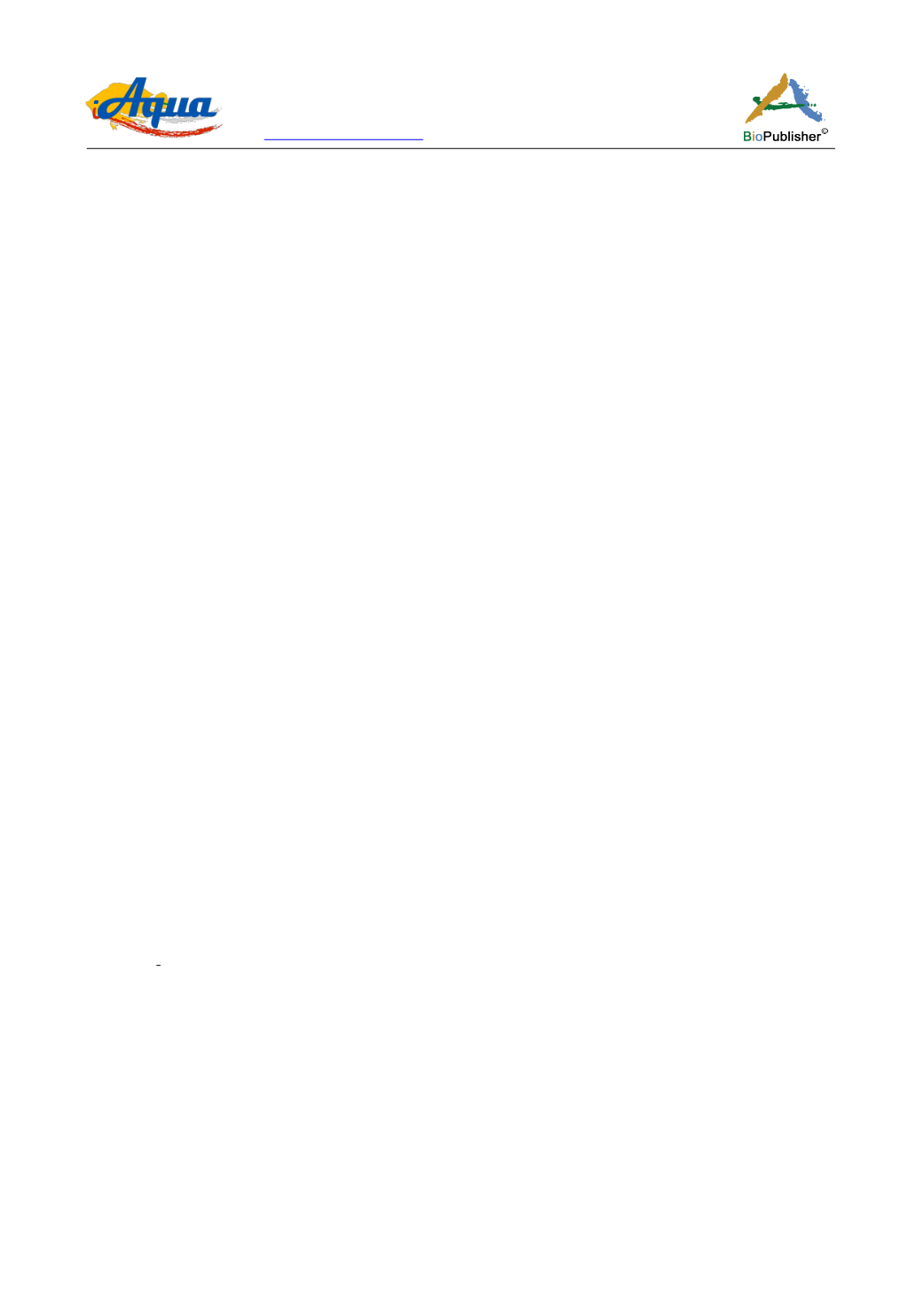
International Journal of Aquaculture, 2017, Vol.7, No.6, 42
-
50
48
et al., 1998), also showed significant difference (p>0.05) within the treatment
s
which inferred that the inclusion of
OGM’s do negate the response of the fish to the diet.
This result is contrary to the report of Eyo and Ezechie (2004) when they feed “
Heteroclarias
” fingerling
s
with
rubber feed meal
s
. They reported that acceptability and striking time of the experimental diets by the fish were
better in the control diet compared to those with rubber seed. Gwiazda et al. (1983) had reported that feed
deterrent, depressant reduced palatability and acceptability index. The findings from the present study implies that
acceptability index is not better in the experimental diets than the control, but voluntary intake, nutritional
efficiency, feed utilization were similar to the observation of Devakumar and Dev (1993). The feed conversion
ratio from OGM1-OGM4 indicates better utilization by the
C. gariepinus
and is within the range of 2.56 - 6.5
reported by Adewole (2015), but for the ≥ OGM5 diets, it indicates poor utilization of these diets. The increasing
percentage mortality as the concentration increases or ≥ OGM5 diets showed in this present study is in agreement
with Devakumar and Dev (1993), which reported as high as 50% mortality in livestock fed neem cake. The
highest percentage mortality was observed from the fish fed OGM6 diet. This may be due to the presence of
antinutritional and highly toxic compounds such as saponins, thymol, tannins, glycosides and alkaloids that are
known to be toxic to body system Ojo et al. (2013). Furthermore, the observed mortality in
C
.
gariepinus
fed ≥
OGM5 diets may be due to the influence of these bioactive components of
O
.
gratissimum
interfering with protein
metabolism at higher concentrations as reported by Iweala and Obidoa (2010) that the consumption of
O
.
gratissimum
significantly reduced the serum protein in rats. The quantification of these bioactive substances in
O.
gratissimum
and their pharmacological impacts were evaluated in the present study. Effraim et al. (2000) reported
that
O. gratissimum
extract contain flavonoids, while Nyahangare et al. (2012) observed that ordinarily, these
flavonoids are umbiquitous in plants are not toxic. However, their occurrence in plant at such high levels coupled
with other bioactive compounds and high doses may enhance the apparent toxicity of
O. gratissimum
in the
present study as reflected in reduced feed intake and higher mortality experienced in
C. gariepinus
fed ≥ OGM5
diets compared to the other diets, with increased feed intake and reduced mortality. The above submission is
similar to Ojo et al. (2013) that indicated the toxic effect of
O. gratissimum
leave extracts at 4 µg/kg may be due
to combined toxicity of the phyto - chemical constituents from the leave
s
of
O. gratissimum.
The mortality
observed in the control and OGM2-OGM4 diets may be attributed to the handling stress during the culture period.
Contrarily, Iweala and Obidoa (2010) reported the positive influence of
O
.
gratissimum
on the weight of Swiss
albino rat fed 5% of ground leaves of
O
.
gratissimum
for 6 months compared to the control.
It was observed that
Ocimum gratissimum
supplemented diet resulted in increased weight gain in the animals
which was attributed to the nutrient composition of leaves of
O
.
gratissimum.
These elaborate nutrients that can
increase weight includes: carbohydrates, lipids, protein, minerals and vitamins (Edeoga et al., 2006). While
Oladunmoye (2006), reported that
O
.
gratissimum
serve as immune booster by increasing the weights of both rats
infected with
Escherichia coli
and treated with ethanolic extract of
O
.
gratissimum
and rats given
O
.
gratissimum
alone. The author conclusively recommended that low concentration or regular intake of the plant extract is able
to cure
E.coli
infection and increase the weight too. Therefore the results obtained for
C. gariepinus
fed
OGM2-OGM4 diets were similar to Vincenzi et al. (2000), Iweala and Obidoa (2010) and Oladunmoye (2006).
Economic evaluation of feeding
C. gariepinus
fingerlings on
Ocimum gratissimum
diets, indicated that the lower
inclusion levels (OGM2-OGM4) had the cost of production and benefit cost positively favoring their utilization,
since these values are greater (>1 .0), while the upper inclusions (OGM5-OGM6) had cost benefit ratio of less
than (<1.0) and also lower than the control. This result obtained here similar to the reported profitability of
Roselle and Bitter leaf evaluated for the same fish Adewole (2014); Adewole (2015) respectively. Furthermore,
these observations may be due to fact that the herbs being used as spices, could be better tolerated at lower
inclusion levels, because spices or additives have some chemical compounds that may be harmful to animal (fish)
especially if used in excess of recommendation Odo (2007). The result from this finding revealed significantly
better total final weight, mean final weight, and better feed intake at the lower inclusion levels, suggesting more


